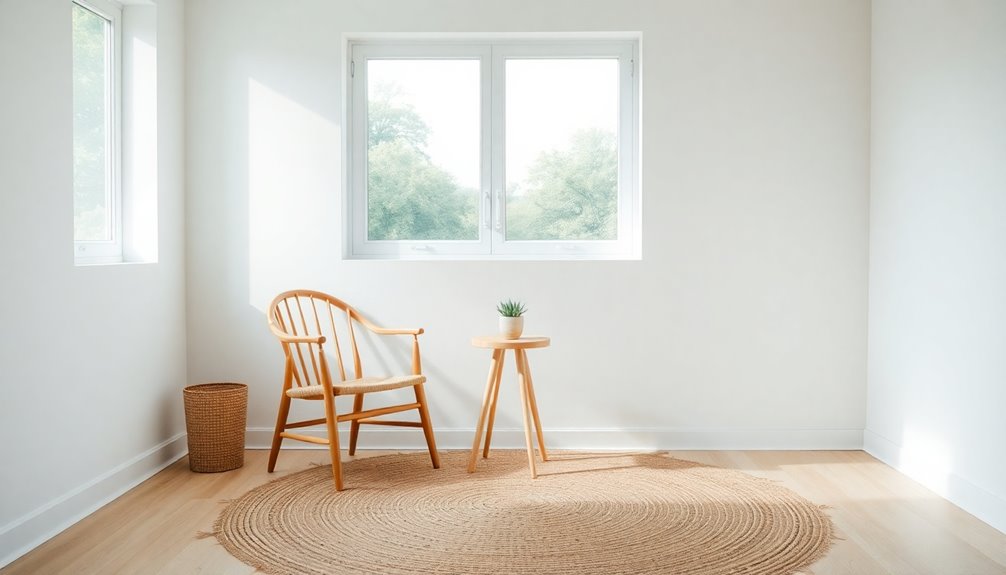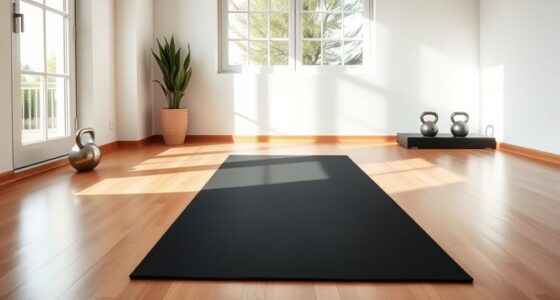To embrace a minimalist lifestyle, start by understanding your motivations for simplification. Tackle decluttering in small steps, perhaps tackling one drawer at a time. Set achievable goals to keep you on track. Create a capsule wardrobe with high-quality pieces, and limit digital distractions to enhance focus. Practice mindfulness to appreciate what you have, prioritize experiences over possessions, and nurture meaningful relationships. Follow these steps, and you'll discover even more ways to simplify your life.
Key Takeaways
- Clarify your values and motivations for minimalism to set realistic decluttering goals that align with your priorities.
- Start small by decluttering one drawer or shelf at a time to make the process manageable and less overwhelming.
- Create a capsule wardrobe with 20 to 40 versatile, high-quality pieces that spark joy and reduce clutter.
- Limit digital distractions by unsubscribing from unwanted emails and establishing specific times for technology use.
- Practice mindfulness through meditation and prioritize experiences over possessions to enhance overall well-being and satisfaction.
Understand Your Why
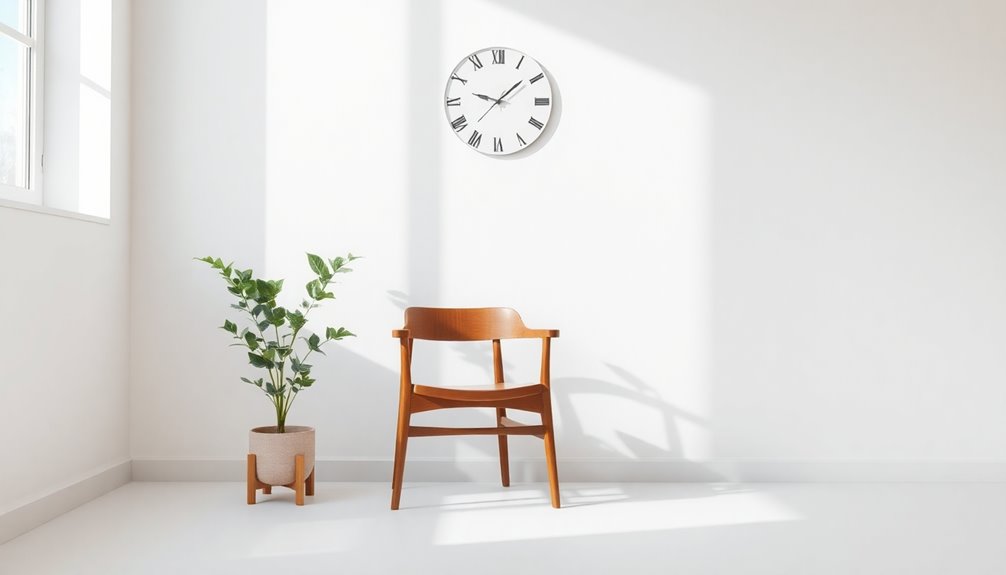
Why do you want to embrace a minimalist lifestyle? Understanding your "why" is vital for clarifying your personal values and priorities.
It'll serve as your motivation throughout the decluttering process. Do you want to reduce debt, decrease stress, or create more quality time with loved ones?
Identifying these reasons will remind you of your purpose during challenging moments. Reflecting on your motivations not only guides your decisions on what to keep or let go but also helps you focus on long-term goals instead of societal pressures to accumulate more.
Engaging in conversations about your reasons can strengthen your commitment and inspire others to contemplate their own motivations for simplifying their lives. Additionally, a cleaner environment can enhance your overall well-being and support your minimalist journey.
Embrace your "why" and let it guide you.
Start Small With Decluttering
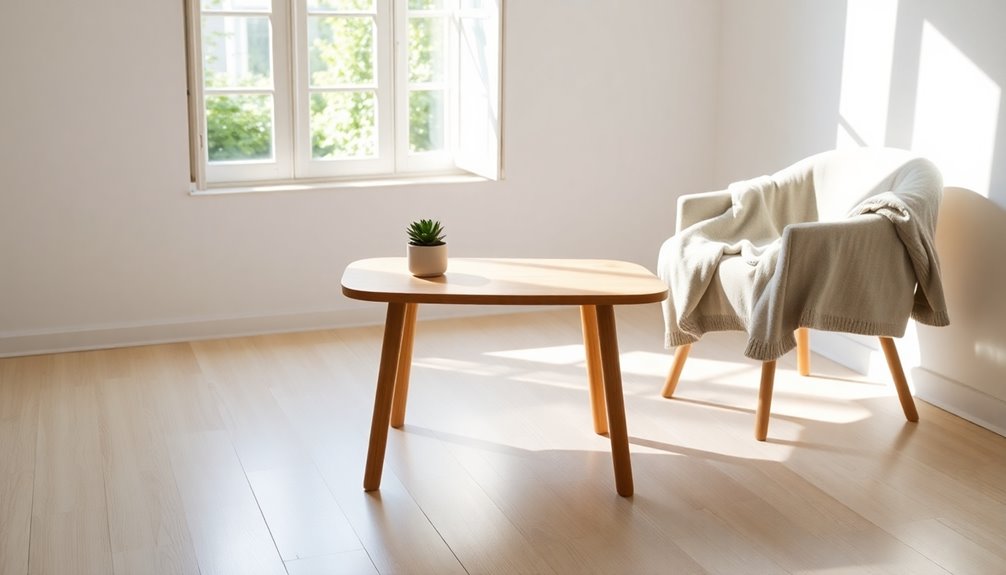
Starting your decluttering journey can feel intimidating, but tackling just one small area at a time makes it manageable and less overwhelming.
Consider beginning with a single drawer or shelf to declutter your home effectively. Utilize the KonMari Method by asking yourself if each item sparks joy—keep only those that do.
Start small by decluttering one drawer or shelf, focusing on items that truly spark joy.
Setting a timer for 15-30 minutes creates urgency, making the task feel less challenging. You might also try the "30-Day Minimalism Game," where you eliminate one item on day one, two on day two, and so on.
Celebrate small victories along the way, as recognizing your progress motivates you to continue and embrace minimalism, ultimately freeing yourself from unnecessary stuff that clutters your life. Additionally, incorporating stress management techniques can help maintain focus and reduce any anxiety related to the decluttering process.
Set Realistic Goals
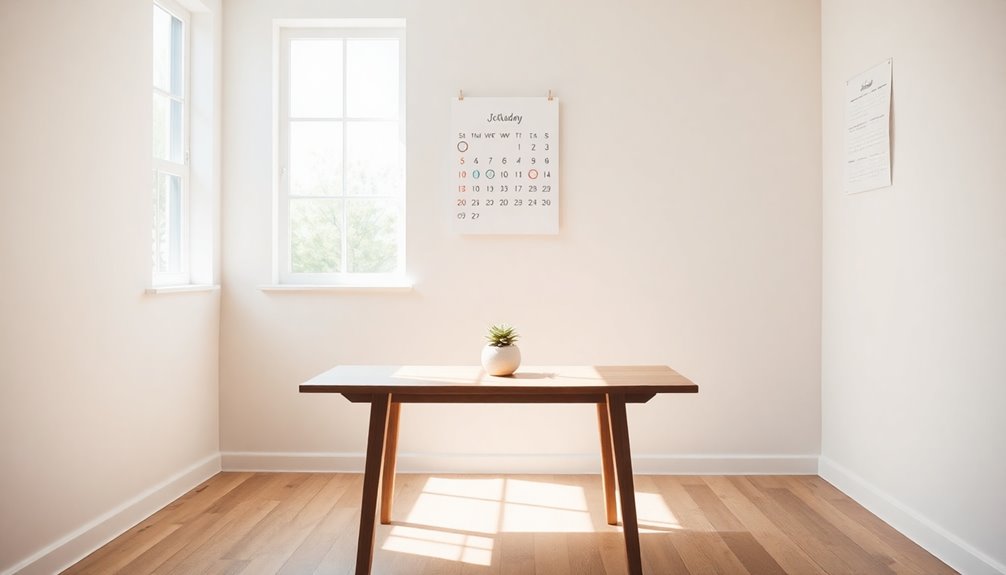
Once you've tackled the initial decluttering, it's time to set realistic goals to keep your momentum going. Focus on specific areas in your home, and aim to declutter a defined number of items each week—about 10 to 20. This manageable pace helps you reflect on the importance of each possession. Consider a timeline like a 30-day challenge to maintain motivation and celebrate small victories. Use the SMART criteria to guarantee your goals are clear and attainable. Regularly review and adjust your goals to stay aligned with your evolving values. Incorporating protein-rich breakfasts can also help you maintain energy levels during your decluttering journey.
| Goal Type | Description | Example |
|---|---|---|
| Specific | Identify a clear area to declutter | Declutter the closet |
| Measurable | Set a number of items to remove | Remove 15 items weekly |
| Achievable | Make sure it fits your lifestyle | Dedicate 30 minutes daily |
| Time-bound | Establish a deadline | Complete in 30 days |
Simplify Your Living Space
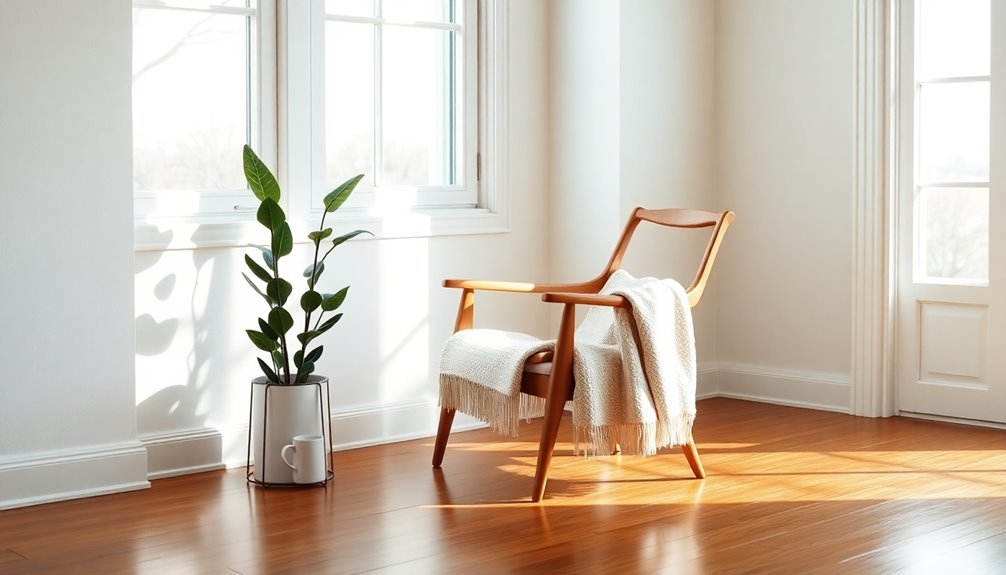
To simplify your living space, start by decluttering regularly to remove items that no longer serve a purpose. Organizing your belongings can make a big difference, so consider limiting decorative items that clutter your view. With a focused approach, you'll create a more peaceful and functional environment. Additionally, incorporating natural materials like wood can enhance the minimalist aesthetic while adding warmth to your space.
Declutter Regularly
While it might seem overwhelming at first, regularly decluttering your living space can transform your home into a sanctuary of calm. By dedicating just 10-15 minutes each day to assess and remove non-essential items, you can greatly reduce stress and cognitive overload, promoting better mental health.
Embrace minimalism by implementing the "one in, one out" rule—every time you bring something new home, let go of an old item. Consider methods like the KonMari Method to keep only those things that spark joy, creating a more meaningful collection.
Additionally, establish designated clutter-free zones in your home to encourage mindfulness and reduce distractions. This simple practice can help you simplify your life and enjoy a serene environment. Regular decluttering not only supports a healthier lifestyle but also fosters a more productive and focused environment.
Organize Your Belongings
Organizing your belongings is essential for creating a simplified living space that promotes clarity and peace. Start by decluttering one small area at a time, using methods like the KonMarie Method to keep only items that spark joy or serve a clear purpose.
Once you've decluttered, implement effective storage solutions, such as labeled bins or containers, to guarantee your essential belongings are organized and easily accessible. Regularly assess your possessions and establish a routine to maintain a tidy space, preventing future clutter from building up.
Consider adopting a capsule wardrobe to streamline your clothing choices, minimizing decision fatigue. Finally, utilize digital tools like organization apps to enhance productivity and reinforce your minimalist mindset. Additionally, incorporating effective storage solutions can further enhance your organizational efforts, ensuring a more serene environment.
Limit Decorative Items
After you've organized your belongings, the next step is to limit decorative items in your space.
Reducing visual clutter can enhance your mental clarity and create a serene living environment. Focus on a few meaningful decorative pieces that evoke joy or represent your values, leading to a greater appreciation for your minimalist home.
Consider adopting a "one in, one out" rule—adding a new item means removing an existing one to maintain balance.
Also, utilize multifunctional decor, like storage baskets or books that are both aesthetic and practical.
Regularly assess your decorative items for relevance and emotional resonance, ensuring each piece contributes positively to your home ambiance.
Embrace simplicity and enjoy a more harmonious space. Additionally, creating a cozy atmosphere can be enhanced by utilizing recycled materials to make DIY decorations that align with your minimalist approach.
Create a Capsule Wardrobe

Creating a capsule wardrobe not only simplifies your closet but also enhances your daily life. This collection typically consists of 20 to 40 versatile pieces that focus on quality over quantity.
By investing in timeless items, you reduce clutter and save money in the long run, as high-quality pieces last longer than fast fashion trends.
Investing in timeless pieces not only cuts clutter but also saves money, as quality lasts longer than fleeting trends.
To start, assess your current clothing collection, keeping only what fits well, suits your lifestyle, and sparks joy. You might try the Project 333 challenge, where you select 33 items to wear for three months.
This method streamlines your choices, helps you avoid decision fatigue, and makes getting dressed a breeze. Additionally, adopting a minimalist lifestyle can lead to greater mental clarity and focus, allowing you to prioritize what truly matters. Embrace the simplicity of a capsule wardrobe and enjoy a more organized life.
Limit Digital Distractions
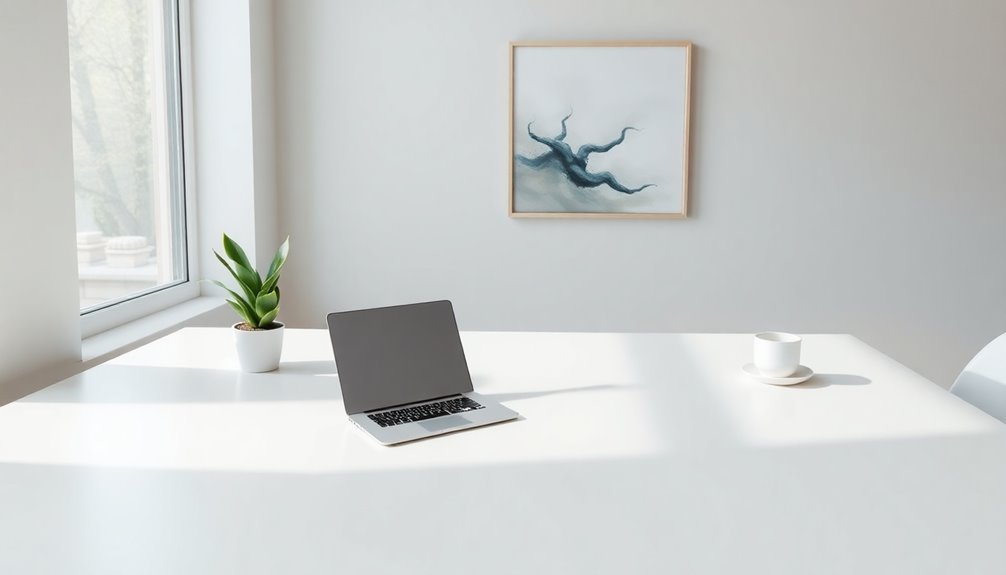
To truly limit digital distractions, start by unsubscribing from unwanted emails that clutter your inbox and waste your time. Setting screen time limits can also help you focus on what matters most in your day. Additionally, effective email strategies can streamline your communications and reduce unnecessary digital noise.
Unsubscribe From Unwanted Emails
Unsubscribing from unwanted emails can drastically simplify your digital life and reduce distractions.
With the average person receiving over 100 emails daily, it's easy to see how digital clutter can lead to stress. By taking a few minutes to declutter your inbox, you can improve focus and enhance mental well-being.
Here's how unsubscribing can benefit you:
- Save time managing your emails
- Reduce decision fatigue from overwhelming choices
- Enjoy a cleaner, more organized inbox
- Minimize anxiety caused by constant notifications
- Increase productivity by focusing on important messages
Email services often have one-click unsubscribe options, making it effortless to eliminate distractions.
Embrace this simple step, and you'll find more clarity in your digital space.
Set Screen Time Limits
After clearing out unwanted emails, it's time to tackle another source of digital clutter: screen time. Setting screen time limits can minimize distractions and help you focus on what truly matters, enhancing your journey toward simple living.
Research shows that excessive screen time can lead to increased anxiety and depression, which adds to your stressful life. By using app trackers and timers, you'll become more aware of your habits and encourage intentional technology use.
Establishing digital-free zones or specific times in your day can foster deeper connections with loved ones and create a peaceful environment with less clutter. Reducing screen time also improves sleep quality, allowing you to recharge for a more mindful and fulfilling life. Additionally, adopting a budgeting strategy can help you allocate time more effectively, ensuring that you prioritize what truly matters.
Embrace Quality Over Quantity

Many people find themselves overwhelmed by the sheer volume of possessions they accumulate over time. Embracing quality over quantity can transform your relationship with your belongings.
By investing in fewer, high-quality items, you'll enjoy a more satisfying ownership experience while reducing waste and saving money. Focus on thoughtful consumption to create a more meaningful lifestyle.
- Durable kitchenware
- High-quality clothing
- Reliable electronics
- Well-crafted furniture
- Sustainable home goods
These items not only serve your needs effectively but also contribute to a healthier planet.
When you prioritize quality, you shift away from consumerism, leading to increased satisfaction and happiness with what you own. Start curating your space with items that truly matter.
Practice Mindfulness
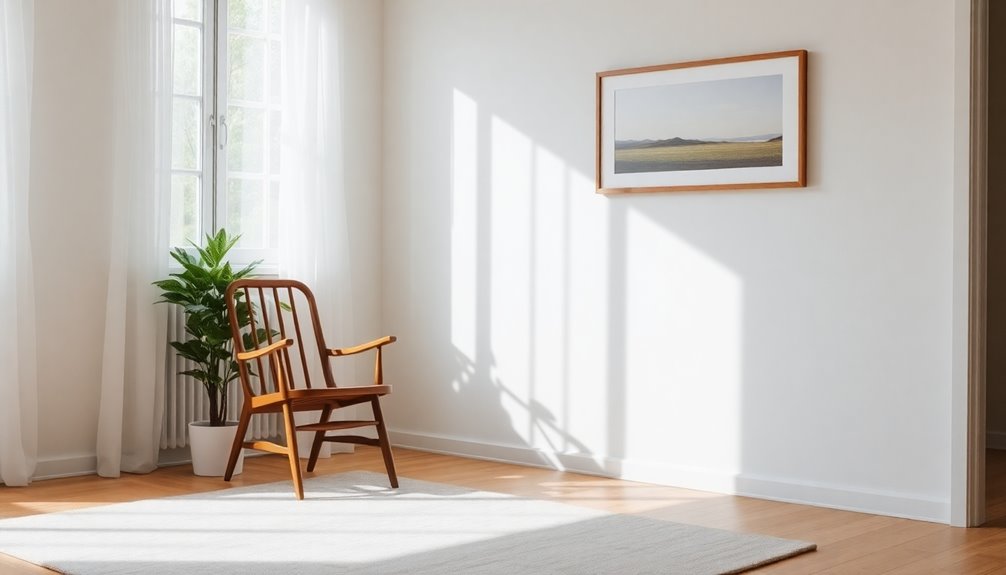
Practicing mindfulness helps you cultivate present moment awareness, allowing you to truly connect with your thoughts and feelings.
By doing so, you can identify your core values, which is essential for a minimalist lifestyle.
This focused approach not only reduces stress but also empowers you to make intentional choices about what really matters in your life.
Cultivate Present Moment Awareness
While embracing a minimalist lifestyle, cultivating present moment awareness through mindfulness can profoundly impact your well-being.
By focusing on the present moment, you reduce anxiety and stress, allowing you to let go of material possessions that no longer serve you. Mindfulness enhances self-awareness and fosters gratitude, helping you appreciate what you already have.
Here are some simple mindfulness practices to incorporate into your daily routine:
- Meditate for a few minutes each day.
- Practice deep breathing to center yourself.
- Take mindful walks in nature.
- Journal about your feelings and experiences.
- Engage in gratitude exercises to recognize abundance.
These practices not only promote calm but also align with minimalist values, prioritizing meaningful experiences over excess.
Identify Core Values
As you cultivate present moment awareness, it becomes easier to identify your core values, which are the foundation of a minimalist lifestyle.
Mindfulness encourages self-reflection, helping you evaluate your possessions and commitments against what truly matters to you. By engaging in techniques like meditation or journaling, you enhance your awareness of consumption habits and foster intentional living.
This clarity aids in decluttering your life, making decisions simpler and more aligned with your values. Regularly revisiting your core values guarantees you stay on track with your minimalist goals, promoting ongoing growth and fulfillment.
Embracing this process not only simplifies your surroundings but also enriches your life with purpose and meaning.
Focus on Experiences
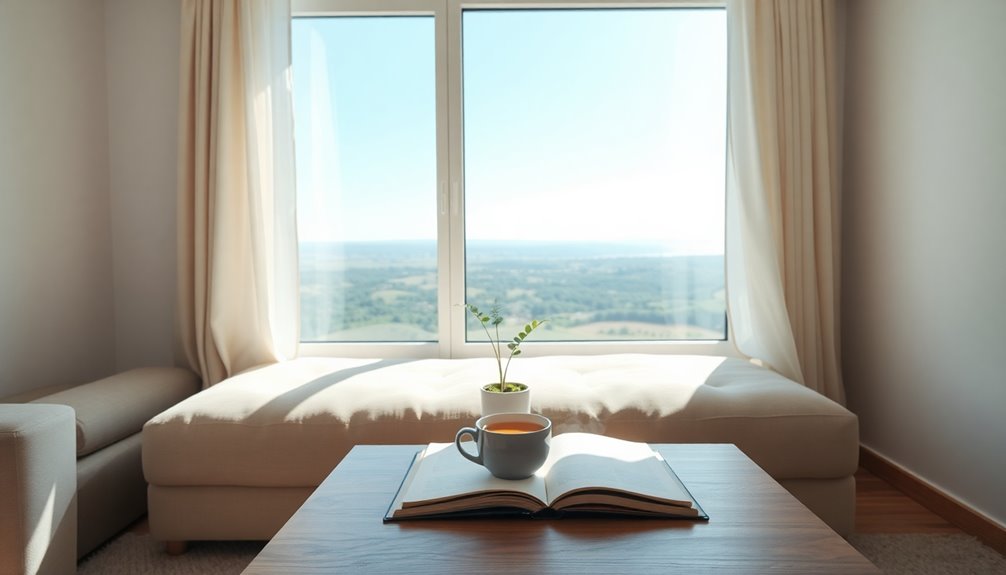
Experiences enrich our lives in ways that material possessions simply can't match. Focusing on experiences fosters deeper connections with others and enhances your happiness.
When you prioritize shared moments, you create lasting memories and cultivate a sense of fulfillment. Here are some ways to embrace a minimalist lifestyle through experiences:
- Travel to new places
- Explore personal hobbies
- Attend community events
- Volunteer for a cause
- Participate in workshops or classes
Investing in experiences not only contributes to your identity but also encourages personal growth and exploration.
Research shows that those who prioritize experiences report higher life satisfaction and lower levels of regret.
Foster Meaningful Relationships
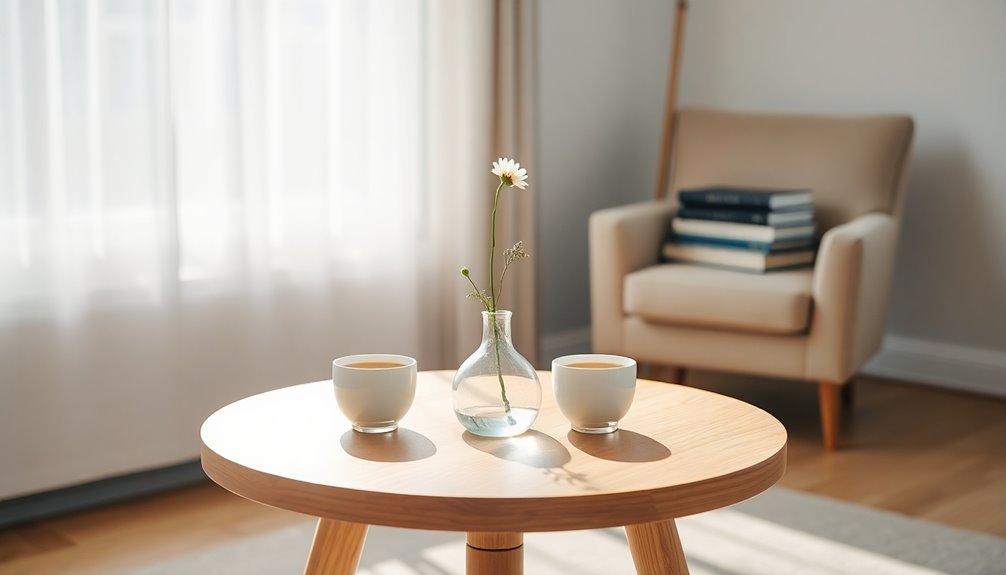
Fostering meaningful relationships becomes easier when you prioritize quality time over material distractions.
By embracing minimalism, you can reduce distractions that often pull your attention away from loved ones. Decluttering both your physical and mental spaces allows you to focus more on meaningful interactions, fostering deeper connections.
Instead of juggling numerous superficial relationships, you can invest your energy in nurturing the bonds that truly matter. Research shows that those who prioritize experiences over possessions report higher happiness levels, reinforcing the idea that relationships are key to fulfillment.
As you simplify your life, you'll likely find yourself more grateful for the time spent with friends and family, enhancing the appreciation for these invaluable connections.
Frequently Asked Questions
How to Embrace a Minimalist Lifestyle?
Embracing a minimalist lifestyle might seem like an overwhelming quest, akin to scaling Everest without gear! But you've got what it takes.
Start by decluttering your space—banish everything that doesn't spark joy. Next, practice mindful shopping; quality over quantity is your mantra.
Simplify your schedule, focusing only on what truly matters. Create a capsule wardrobe to streamline your outfits.
Finally, declutter your digital life to cultivate a serene online presence. You've got this!
What Is the 30 Day Rule for Minimalism?
The 30 Day Rule for minimalism encourages you to declutter gradually over a month.
You'll start by removing one item on day one, then two items on day two, and so forth. By the end of the 30 days, you could clear out 465 items!
This approach makes decluttering manageable and less overwhelming, helping you reassess what truly adds value to your life while fostering sustainable habits for a minimalist lifestyle.
How to Become a Minimalist Step by Step?
To become a minimalist step by step, start by tackling one small area at a time.
It's a case of "biting off more than you can chew" if you try to do it all at once. Gradually declutter items that don't serve you.
Consider implementing the 30-Day Minimalism Game to keep it structured.
Focus on quality over quantity in your purchases, and regularly assess what aligns with your values to maintain simplicity.
What Is the 90 10 Rule Minimalism?
The 90/10 Rule in minimalism suggests that your happiness largely comes from your mindset, not your stuff.
It's about realizing that 90% of your joy is shaped by your attitude and relationships, while only 10% is tied to material possessions.
By focusing on meaningful experiences and personal growth, you can enhance your well-being.
This shift in perspective encourages you to let go of excess and prioritize what truly matters in life.
Conclusion
Embracing a minimalist lifestyle can transform your life, making it more intentional and fulfilling. By focusing on what truly matters, like experiences over possessions, you'll find greater happiness. For instance, consider Sarah, who downsized her belongings and redirected her savings toward traveling. Instead of accumulating more clothes, she explored new cultures, which enriched her life far beyond material things. So, take these steps, simplify your life, and watch how it opens up space for what you genuinely love.
